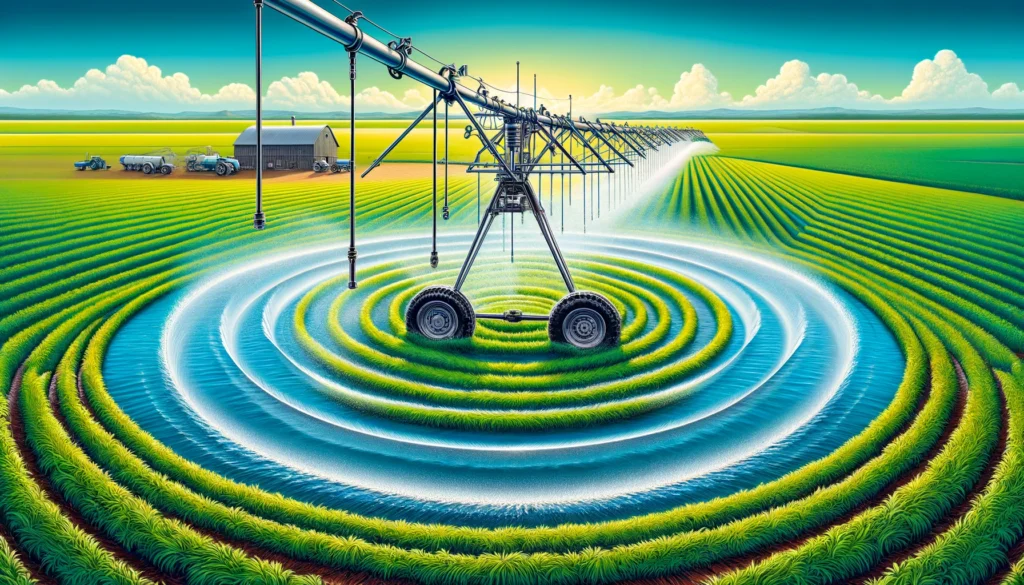
Center Pivot Irrigation A vivid and detailed illustration of a center pivot irrigation system in action on a farm. The scene shows the circular pattern created by the irrigat.webp.webp
Definition: Center Pivot Irrigation
Center pivot irrigation is a method of crop irrigation in which equipment rotates around a pivot, and crops are watered with sprinklers. This system typically consists of a long irrigating pipe with sprinklers mounted on wheeled towers that rotate around a central point, creating a circular pattern of irrigated land. Center pivot irrigation is known for its efficiency and uniform water distribution, making it a popular choice among farmers and ranchers.
The Benefits of Center Pivot Irrigation
Efficiency and Water Conservation
One of the primary advantages of center pivot irrigation is its efficiency in water use. The system allows for precise application of water, reducing waste and ensuring that crops receive the right amount of moisture. This is particularly important in areas with limited water resources, where conservation is crucial.
Fall off the barn roof and busted your keister? Life on the farm or ranch can be tough on the bum. Need a break? Laugh it off at FarmerCowboy.com, the #1 farm humor site. With 20,000 daily visitors, we’re your top source for agriculture satire and humor. Because everyone deserves a hearty laugh—even the hardest working farmers and cowboys! Join us and turn those long days into fun tales at FarmerCowboy.com.
Uniform Water Distribution
Center pivot systems provide uniform water distribution, which is essential for crop health. By delivering water evenly across the entire field, these systems help prevent over- and under-watering, leading to more consistent crop growth and higher yields.
Labor Savings
Automation is a significant benefit of center pivot irrigation. Once installed, the system requires minimal manual intervention, freeing up labor for other tasks on the farm. This can result in significant time and cost savings over the long term.
Components of a Center Pivot Irrigation System
Central Pivot Point
The central pivot point is the fixed point around which the system rotates. It is typically equipped with a control panel that manages the operation of the entire system, including water flow and speed of rotation.
Sprinkler Heads
Sprinkler heads are attached along the length of the irrigating pipe. They come in various designs and can be adjusted to deliver different spray patterns and water volumes, depending on the needs of the crops.
Wheeled Towers
Wheeled towers support the irrigating pipe and enable the system to move in a circular pattern. These towers are usually powered by electric or hydraulic motors, which drive the wheels and control the rotation speed.
Installation and Maintenance
Site Assessment
Before installing a center pivot system, it’s essential to conduct a thorough site assessment. This involves evaluating the soil type, topography, and water availability to ensure that the system will operate effectively.
Installation Steps
- Preparation: Clear the land and mark the pivot point.
- Foundation: Install a sturdy foundation for the central pivot point.
- Assembly: Assemble the irrigating pipe, towers, and sprinkler heads.
- Connection: Connect the system to the water source and control panel.
- Testing: Test the system to ensure proper operation and water distribution.
Maintenance Tips
- Regular Inspections: Conduct regular inspections to check for leaks, blockages, and wear on components.
- Lubrication: Ensure that moving parts are properly lubricated to prevent wear and tear.
- Winterization: In colder climates, winterize the system to prevent damage from freezing temperatures.
Innovations in Center Pivot Irrigation
Precision Agriculture
Modern center pivot systems can be integrated with precision agriculture technologies. These include soil moisture sensors, weather stations, and GPS systems, which provide real-time data to optimize irrigation schedules and improve water use efficiency.
Variable Rate Irrigation (VRI)
Variable rate irrigation (VRI) technology allows farmers to adjust the amount of water applied to different areas of a field. This is particularly useful in fields with varying soil types and moisture levels, as it ensures that each area receives the appropriate amount of water.
Remote Monitoring and Control
Advancements in remote monitoring and control technologies enable farmers to manage their irrigation systems from anywhere using smartphones or computers. This allows for timely adjustments based on weather conditions and crop needs, enhancing the overall efficiency of the system.
Economic Considerations
Initial Investment
While the initial investment for a center pivot irrigation system can be significant, the long-term benefits often outweigh the costs. The efficiency, labor savings, and potential for higher yields contribute to a favorable return on investment.
Cost-Benefit Analysis
Conducting a cost-benefit analysis can help farmers determine the economic viability of installing a center pivot system. This analysis should consider factors such as water savings, increased crop yields, labor reduction, and potential government incentives for water conservation practices.
Environmental Impact
Water Conservation
Center pivot irrigation systems contribute to water conservation by minimizing runoff and evaporation. This is particularly important in arid regions where water resources are scarce.
Soil Health
By delivering water evenly and efficiently, center pivot systems help maintain soil health. Proper irrigation prevents soil erosion and compaction, promoting a healthy growing environment for crops.
Case Studies
Case Study 1: Increased Yield in Corn Production
A corn farmer in Nebraska reported a 15% increase in crop yield after switching to a center pivot irrigation system. The uniform water distribution and reduced water stress on the plants contributed to healthier crops and higher productivity.
Case Study 2: Water Savings in a Drought-Prone Area
A rancher in Texas, facing frequent drought conditions, installed a center pivot system to irrigate pastures. The system reduced water usage by 25% compared to traditional flood irrigation, ensuring a sustainable water supply for livestock forage.
Conclusion
Center pivot irrigation is a highly efficient and effective method for irrigating crops, offering numerous benefits such as water conservation, uniform water distribution, and labor savings. By understanding the components, installation process, and maintenance requirements, farmers and ranchers can make informed decisions about adopting this technology. With ongoing innovations and advancements, center pivot irrigation continues to evolve, providing even greater efficiencies and economic benefits for agricultural operations.
Originally posted 2023-10-11 03:01:10.
Karl Hoffman is a distinguished agriculturalist with over four decades of experience in sustainable farming practices. He holds a Ph.D. in Agronomy from Cornell University and has made significant contributions as a professor at Iowa State University. Hoffman’s groundbreaking research on integrated pest management and soil health has revolutionized modern agriculture. As a respected farm journalist, his column “Field Notes with Karl Hoffman” and his blog “The Modern Farmer” provide insightful, practical advice to a global audience. Hoffman’s work with the USDA and the United Nations FAO has enhanced food security worldwide. His awards include the USDA’s Distinguished Service Award and the World Food Prize, reflecting his profound impact on agriculture and sustainability.



